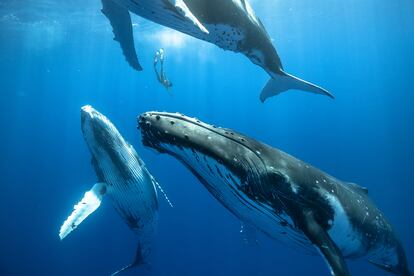Whale song is no match for ship noise
An analysis of the animal’s larynx reveals how they adapted to communicate underwater and their physical limits producing sound

About 50 million years ago, the ancestors of whales — which also gave rise to the modern-day cow — left life on land and returned to the sea. With them, they took with them their system for producing sound, which is not unlike that used by humans.
But this system does not operate the same way underwater — indeed, opening the mouth to produce sound leads to drowning. In adapting to the new environment, some species of cetaceans developed such sophisticated phonation that they appeared to humans to be singing. Now, a group of scientists has dissected three specimens to uncover the secrets of their singing. Over the course of evolution, these animals redesigned their larynx to continue communicating over very long distances. But the study also shows how the noise generated by humans is short-circuiting their ability to communicate. They still sing, but they can no longer hear each other.
The different cetaceans developed adaptations to the new environment: odontocetes (dolphins, killer whales, sperm whales...) evolved to have a nasal vocal organ capable of producing high frequency sounds, while dolphinids used this organ for echolocation. Meanwhile, the mysticete whales (blue whale, humpback whale, fin whale...) have almost completely redesigned their larynx. This organ — one of the most complex in mammals — has two functions: to protect the airways and the lungs and for phonation.
In most terrestrial species, this phonation involves the vibration of the vocal cords, which is caused by the flow of air through the glottis, the opening between the vocal folds. But life underwater led to radical adaptations. The result, particularly among baleen whales, far surpassed the communication of their terrestrial ancestors. These animals are able to emit sounds that travel tens or even hundreds of kilometers. But most of what was known about the phonation system of the mysticete whales was based on assumptions and inferences.
Between 2018 and 2019, a group of scientists specializing in cetacean phonation organized to get their hands on the larynxes of some whales. They needed them to be as fresh as possible, it was the only way to study them in depth. The scientists contacted environmental organizations and asked them to warn them of any whale stranding. They obtained this organ from three species of mysticetes: a minke whale, a sei whale and an imposing humpback whale. For centuries, the humpback whale has enchanted seafarers with their calls.
The three specimens were dissected so that their anatomy could be understood in greater depth. In principle, they have all the elements present in the rest of mammals, such as several basic cartilages for laryngeal articulation and sound production. But they do not have vocal cords like those of humans and other land animals, and some of these cartilages have hardened and lost their original function. Instead, they have developed a U-shaped structure (as seen from above) parallel to the trachea, which has a horizontal orientation — not a vertical one as in the human species. And on top of this shape, there is a pad of blubber.
What the researchers did, as detailed in the journal Nature, was to mechanically blow air into the larynxes. They saw how the air made the arms of the U vibrate and, when in contact with the blubber on top, produced low-frequency sounds similar to those emitted by these whales.
“We believe they have evolved new structures because the vocal cords would hinder rapid breathing at the surface,” explains Professor Coen Elemans, from the sound communication and behavior group at the University of Southern Denmark, who is the lead author of this groundbreaking research. “Using these structures, whales can emit very low-frequency sounds that they all make,” he adds.
Although the physical mechanisms underlying sound production (airflow-induced vibrations) are the same as in human speech and song, the scientists confirmed that “only a few species [humpback and bowhead whales] redeveloped the ability to move the cartilages of the larynx and the thick tissues above these structures so that they can move them together again. Just like our vocal cords,” adds Elemans. This also allows them to emit high-frequency sounds, “the songs that most people know well,” he explains.
In a second part of the work, after scanning the larynx of the humpback whale, the scientists modeled it to study its behavior according to different physical and acoustic constraints. “Our model includes precise 3D shapes of the larynx and its muscles. That made it possible to simulate, for example, how frequency is controlled by muscle modulation,” Qian Xue, a professor in the Department of Mechanical Engineering at the Rochester Institute of Technology in Rochester and co-author of the study, says in a press release.
“Our model accurately predicted the results of our experiments, and we were also able to calculate acoustic characteristics that we could not measure in the lab, such as frequency range,” added his colleague Weili Jiang.
One thing they couldn’t measure in the lab was an issue with wide-reaching implications. The sounds emitted at the surface can reach deep into the sea, but below these whales can’t emit sound below 100 meters. It is physically impossible for them. The problem is that this is the range that is increasingly being filled by sounds from human activities (ships, underwater mining, prospecting...).
Combining these experiments and models, the researchers demonstrated that baleen whales are physiologically unable to get past man-made noise, because it drowns their call and thus limits their communication range. As Elemans explains, “the limited frequency range [between 10 and 300 hertz] and depth [0 to 100 meters] where they can emit sounds overlap with the noise produced by humans; that is why they cannot sing louder or deeper to get around our noises.”
Sign up for our weekly newsletter to get more English-language news coverage from EL PAÍS USA Edition
Tu suscripción se está usando en otro dispositivo
¿Quieres añadir otro usuario a tu suscripción?
Si continúas leyendo en este dispositivo, no se podrá leer en el otro.
FlechaTu suscripción se está usando en otro dispositivo y solo puedes acceder a EL PAÍS desde un dispositivo a la vez.
Si quieres compartir tu cuenta, cambia tu suscripción a la modalidad Premium, así podrás añadir otro usuario. Cada uno accederá con su propia cuenta de email, lo que os permitirá personalizar vuestra experiencia en EL PAÍS.
¿Tienes una suscripción de empresa? Accede aquí para contratar más cuentas.
En el caso de no saber quién está usando tu cuenta, te recomendamos cambiar tu contraseña aquí.
Si decides continuar compartiendo tu cuenta, este mensaje se mostrará en tu dispositivo y en el de la otra persona que está usando tu cuenta de forma indefinida, afectando a tu experiencia de lectura. Puedes consultar aquí los términos y condiciones de la suscripción digital.
More information
Últimas noticias
NASA discovers Titan doesn’t have an ocean, but a ‘slushy ice layer’ that increases possibility of life
Innocence lost in the forest of the child soldiers: ‘Each leader of the armed group had his girls’
‘Fallout’ or how the world’s largest company turned an anti-capitalist apocalyptic Western into a phenomenon
From inflation to defending migrants: Eileen Higgins and Zohran Mamdani inaugurate the new Democratic resistance against Trump
Most viewed
- ‘El Limones’ and the growing union disguise of Mexican organized crime
- Christian Louboutin: ‘Young people don’t want to be like their parents. And if their parents wear sneakers, they’re going to look for something else’
- The low-cost creative revolution: How technology is making art accessible to everyone
- ‘We are dying’: Cuba sinks into a health crisis amid medicine shortages and misdiagnosis
- A mountaineer, accused of manslaughter for the death of his partner during a climb: He silenced his phone and refused a helicopter rescue










































